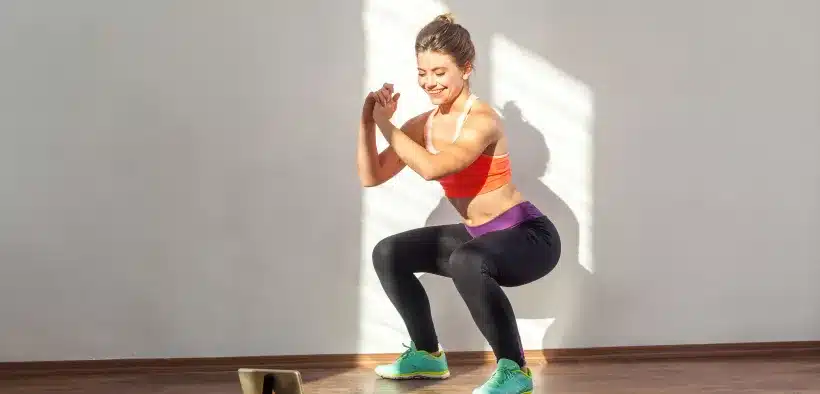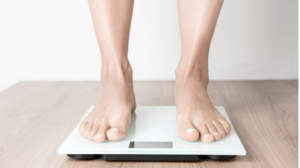How to Squat in Three Simple Steps

Strength training has several benefits including increases in strength, bone density, metabolic rate, and decrease in fat. The squat is a full body movement that gives you more bang for your buck than isolating muscle groups. Building a habit of consistent strength training can be a challenge, so I’ve simplified this movement into the three essentials every squat should include as well as a guide on components that could vary.
1. Weight Distribution
Distribute your weight evenly across the bottom of your foot. Do not press only the front or heel into the ground. It is also important to factor footwear. Running shoes are great for running, but not ideal for strength training. They often lack lateral stability and cause a weight shift into the front of the foot. To have proper weight distribution in your feet, it is better to utilize a shoe with less cushion or potentially without shoes.
2. Knee & Toe Alignment
The knee does not move laterally or rotate. In order to ensure it stays in the optimal range, ensure that your knee follows the alignment of your toes as your knee bends. If your feet have your toes pointed straight ahead, your knees should point the same direction as they bend. Ensure your knees follow the same path as your toes.
3. Spinal Stability
All the muscles between the shoulders and spine are capable of creating tension to stabilize your upper body. While squatting requires movement in your ankle, knee, and hip joints, you want to create tension through your upper body to prevent your upper body from bending laterally, twisting, or excessively hunching and arching your back as you go through the squat. While we ideally keep the back relatively flat, the more important factor is to be stable. If you naturally have a slight arch in your lowerback or rounding of the upper back, just be sure to not arch or round further as you perform your squat.


Now that you are familiar with the necessities, here are a few things that should and will vary!
Stance Width
We are all structurally different. Typically I would encourage individuals to start slightly wider than shoulder width and adjust from there. Find the width that allows you to do the three essentials and goes through a range of motion that feels comfortable for you.
Depth
There is a constant raging debate on how low a person should squat. The right answer is to achieve the depth that your level of strength, flexibility, and confidence allows as long as you do it while still performing the 3 essentials. There is no glory in having your butt touch the floor on a squat if it comes at the risk of your spinal or knee health.
Hip Angle
Some squatters keep their upper body relatively upright while others press their butt back and allow their upper body to sink almost parallel to the floor. Long femurs and limited ankle mobility will require shifting hips farther back. Find the right balance for you based on your body.
Type
There are squats that include bars, dumbbells, kettlebells, and all sorts of equipment. This will depend on your training experience and scope of knowledge. Prior to advancing to squats with additional resistance, I’d encourage mastering the bodyweight squat.
Sets, Reps, and Rest
Exercise is about introducing your body to a stimulant that is slightly more challenging than it is accustomed to in order to produce an adaptation. Too much of a stimulus leads to injury. Too little leads to no adaptation. Treat exercise like education. You can’t achieve your fitness and weight loss goals in a day the same way you can’t learn a new language. Each workout should be a new lesson for the body. That lesson should be based on what your body has previously been exposes to. If program design is new to you, I recommend consulting with an expert.
Conclusion
The squat is a powerful movement that can help you reach your goals. It can also be extremely complex if you allow it to be. Focus on the three necessities and within your comfort zone. As the movement becomes a habit, progressively challenge yourself and you will be an expert squatter in no time!
About Shapa:
Looking to sleep better, eat a bit healthier, build a practice of self-care, or just want to feel more energetic each day? Let Shapa be your virtual coach. Shapa focuses your program based on YOUR lifestyle and YOUR goals so you can build healthy habits and achieve lasting results. Learn more about the Shapa difference.
About the author:
Clayton Key holds a BS in Kinesiology and a MBA from the McCombs School of Business at the University of Texas at Austin. He holds credentials as an Exercise Physiologist through the American College of Sports Medicine and Nutrition Coach through Precision Nutrition. After a decade of working in the fitness industry, he currently wears many hats with Shapa. He is passionate about helping people achieve long-term sustainable behaviors that lead to a happy and healthy life. When not working, you can find him spending time with friends or paddle boarding with his dog Leo on Townlake in Austin, TX.




